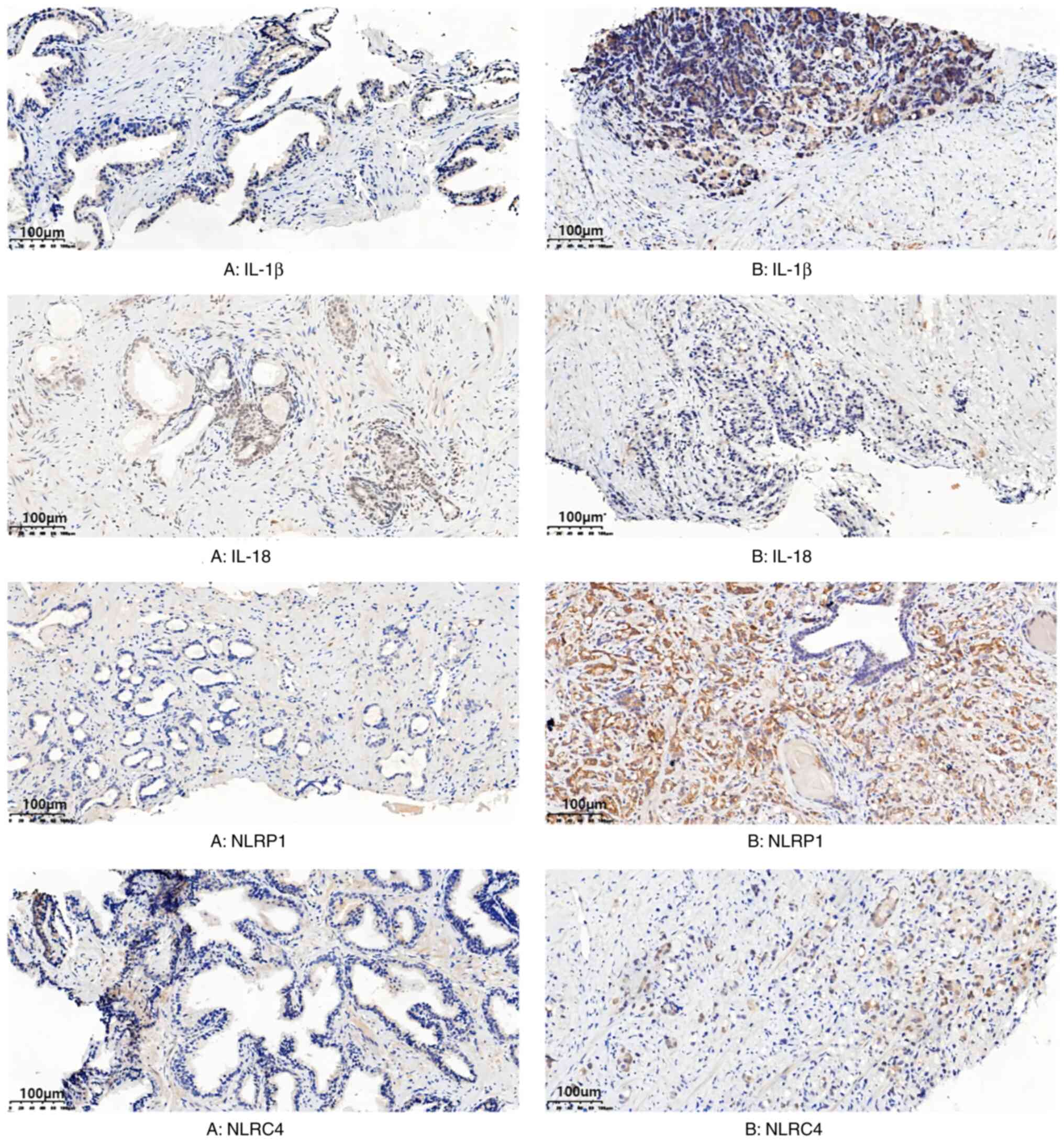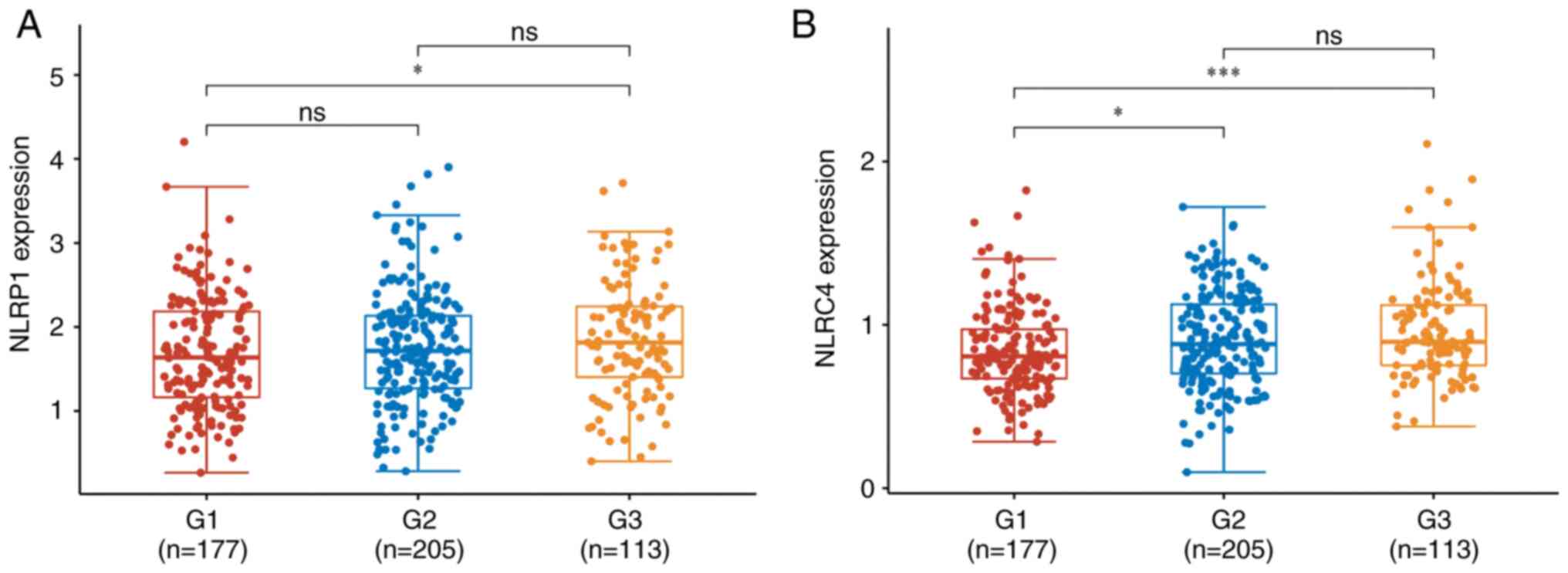|
1
|
Boehm BJ, Colopy SA, Jerde TJ, Loftus CJ
and Bushman W: Acute bacterial inflammation of the mouse prostate.
Prostate. 72:307–317. 2012. View Article : Google Scholar : PubMed/NCBI
|
|
2
|
Guo YL, Na YQ, Ye ZQ and Huang J:
Guidelines for Diagnosis and Treatment of Urology and Andrology
Diseases in China. Science Press; Beijing, China: pp. pp4392019
|
|
3
|
Xie Jinbo and Peng Bo: Research progress
on the epidemiological characteristics and risk factors of benign
prostatic hyperplasia. J Tongji Univ Med Edition. 42:62021.(In
Chinese).
|
|
4
|
Leela SCA, Paes Batista da Silva A, Verma
S, Fu P, Shen DL, MacLennan G, Gupta S and Bissada NF: Presence of
specific periodontal pathogens in prostate gland diagnosed with
chronic inflammation and adenocarcinoma. Cureus.
13:e177422021.PubMed/NCBI
|
|
5
|
Gurel B, Lucia MS, Thompson IM Jr, Goodman
PJ, Tangen CM, Kristal AR, Parnes HL, Hoque A, Lippman SM,
Sutcliffe S, et al: Chronic inflammation in benign prostate tissue
is associated with high-grade prostate cancer in the placebo arm of
the prostate cancer prevention trial. Cancer Epidemiol Biomarkers
Prev. 23:847–856. 2014. View Article : Google Scholar : PubMed/NCBI
|
|
6
|
Mishra V and Pathak C: Human Toll-Like
Receptor 4 (hTLR4): Structural and functional dynamics in cancer.
Int J Biol Macromol. 122:425–451. 2019. View Article : Google Scholar : PubMed/NCBI
|
|
7
|
Krysko DV, Agostinis P, Krysko O, Garg AD,
Bachert C, Lambrecht BN and Vandenabeele P: Emerging role of
damage-associated molecular patterns derived from mitochondyria in
inflammation. Trends Immunol. 32:157–164. 2011. View Article : Google Scholar : PubMed/NCBI
|
|
8
|
Costa FRC, Leite JA, Rassi DM, da Silva
JF, Elias-Oliveira J, Guimarães JB, Foss-Freitas MC, Câmara NOS,
Pontillo A, Tostes RC, et al: NLRP1 acts as a negative regulator of
Th17 cell programming in mice and humans with autoimmune diabetes.
Cell Rep. 35:1091762021. View Article : Google Scholar : PubMed/NCBI
|
|
9
|
Alehashemi S and Goldbach-Mansky R: Human
autoinflammatory diseases mediated by NLRP3-, Pyrin-, NLRP1-, and
NLRC4-Inflammasome dysregulation updates on diagnosis, treatment,
and the respective roles of IL-1 and IL-18. Front Immunol.
11:18402020. View Article : Google Scholar : PubMed/NCBI
|
|
10
|
Moecking J, Laohamonthonkul P, Chalker K,
White MJ, Harapas CR, Yu CH, Davidson S, Hrovat-Schaale K, Hu D,
Eng C, et al: NLRP1 variant M1184V decreases inflammasome
activation in the context of DPP9 inhibition and asthma severity. J
Allergy Clin Immunol. 147:2134–2145.e20. 2021. View Article : Google Scholar : PubMed/NCBI
|
|
11
|
Ciążyńska M, Olejniczak-Staruch I,
Sobolewska-Sztychny D, Narbutt J, Skibińska M and Lesiak A: The
role of NLRP1, NLRP3, and AIM2 inflammasomes in psoriasis: Review.
Int J Mol Sci. 22:58982021. View Article : Google Scholar : PubMed/NCBI
|
|
12
|
Huang T, Yin H, Ning W, Wang X, Chen C,
Lin W, Li J, Zhou Y, Peng Y, Wang M, et al: Expression of
inflammasomes NLRP1, NLRP3 and AIM2 in different pathologic
classification of lupus nephritis. Clin Exp Rheumatol. 38:680–690.
2020.PubMed/NCBI
|
|
13
|
Gong Q, Robinson K, Xu C, Huynh PT, Chong
KHC, Tan EYJ, Zhang J, Boo ZZ, Teo DET, Lay K, et al: Structural
basis for distinct inflammasome complex assembly by human NLRP1 and
CARD8. Nat Commun. 12:1882021. View Article : Google Scholar : PubMed/NCBI
|
|
14
|
Zhang J, Pei L, Zang D, Xue Y, Wang X,
Chen Y, Li J, Yu J, Gao Q, Di W, et al: Gender differences of NLRP1
inflammasome in mouse model of Alzheimer's disease. Front Aging
Neurosci. 12:5120972020. View Article : Google Scholar : PubMed/NCBI
|
|
15
|
Karki R and Kanneganti TD: Diverging
inflammasome signals in tumorigenesis and potential targeting. Nat
Rev Cancer. 19:197–214. 2019. View Article : Google Scholar : PubMed/NCBI
|
|
16
|
Gouravani M, Khalili N, Razi S,
Keshavarz-Fathi M, Khalili N and Rezaei N: The NLRP3 inflammasome:
A therapeutic target for inflammation-associated cancers. Expert
Rev Clin Immunol. 16:175–187. 2020. View Article : Google Scholar : PubMed/NCBI
|
|
17
|
Sundaram B and Kanneganti TD: Advances in
understanding activation and function of the NLRC4 inflammasome.
Int J Mol Sci. 22:10482021. View Article : Google Scholar : PubMed/NCBI
|
|
18
|
Broz P: Recognition of intracellular
bacteria by inflammasomes. Microbiol Spectr. 7:2019. View Article : Google Scholar : PubMed/NCBI
|
|
19
|
Chear CT, Nallusamy R, Canna SW, Chan KC,
Baharin MF, Hishamshah M, Ghani H, Ripen AM and Mohamad SB: A novel
de novo NLRC4 mutation reinforces the likely pathogenicity of
specific LRR domain mutation. Clin Immunol. 211:1083282020.
View Article : Google Scholar : PubMed/NCBI
|
|
20
|
Yang J, Gu J, Hu Y, Wang N, Gao J and Wang
P: Molecular cloning and characterization of HSP60 gene in domestic
pigeons (Columba livia) and differential expression patterns under
temperature stress. Cell Stress Chaperones. 26:115–127. 2021.
View Article : Google Scholar : PubMed/NCBI
|
|
21
|
Barry MJ, Fowler FJ jr, O'Leary MP,
Bruskewitz RC, Holtgrewe HL, Mebust WK and Cockett AT: The American
Urological Association symptom index for benign prostatic
hyperplasia The Measurement Committee of the American Urological
Association. J Urol. 148:1549–1557; discussion 1564. 1992.
View Article : Google Scholar : PubMed/NCBI
|
|
22
|
Chen YJ, Luo SN, Dong L, Liu TT, Shen XZ,
Zhang NP and Liang L: Interferon regulatory factor family
influences tumor immunity and prognosis of patients with colorectal
cancer. J Transl Med. 19:3792021. View Article : Google Scholar : PubMed/NCBI
|
|
23
|
Zhou T, Cai Z, Ma N, Xie W, Gao C, Huang
M, Bai Y, Ni Y and Tang Y: A novel ten-gene signature predicting
prognosis in hepatocellular carcinoma. Front Cell Dev Biol.
8:6292020. View Article : Google Scholar : PubMed/NCBI
|
|
24
|
Sung H, Ferlay J, Siegel RL, Laversanne M,
Soerjomataram I and Jemal Aand Bray F: Global cancer statistics
2020: GLOBOCAN estimates of incidence and mortality worldwide for
36 cancers in 185 countries. CA Cancer J Clin. 71:209–249. 2021.
View Article : Google Scholar : PubMed/NCBI
|
|
25
|
Cao W, Chen HD, Yu YW, Li N and Chen WQ:
Changing profiles of cancer burden worldwide and in China: A
secondary analysis of the global cancer statistics 2020. Chin Med J
(Engl). 134:783–791. 2021. View Article : Google Scholar : PubMed/NCBI
|
|
26
|
Puhr M, De Marzo A, Isaacs W, Lucia MS,
Sfanos K, Yegnasubramanian S and Culig Z: Inflammation, microbiota,
and prostate cancer. Eur Urol Focus. 2:374–382. 2016. View Article : Google Scholar : PubMed/NCBI
|
|
27
|
Ohashi K, Wang Z, Yang YM, Billet S, Tu W,
Pimienta M, Cassel SL, Pandol SJ, Lu SC, Sutterwala FS, et al:
NOD-like receptor C4 inflammasome regulates the growth of colon
cancer liver metastasis in NAFLD. Hepatology. 70:1582–1599. 2019.
View Article : Google Scholar : PubMed/NCBI
|
|
28
|
Schillaci O, Scimeca M, Trivigno D,
Chiaravalloti A, Facchetti S, Anemona L, Bonfiglio R, Santeusanio
G, Tancredi V, Bonanno E, et al: Prostate cancer and inflammation:
A new molecular imaging challenge in the era of personalized
medicine. Nucl Med Biol. 68–69. 66–69. 2019.
|
|
29
|
Yu CH, Moecking J, Geyer M and Masters SL:
Mechanisms of NLRP1-mediated autoinflammatory disease in humans and
Mice. J Mol Biol. 430:142–152. 2018. View Article : Google Scholar : PubMed/NCBI
|
|
30
|
Fan Y, Yang L, Wei Q, Ding Y, Tang Z, Tan
P, Lin T, Guo D and Qiu S: Toll-like receptor 10 (TLR10) exhibits
suppressive effects on inflammation of prostate epithelial cells.
Asian J Androl. 21:393–399. 2019. View Article : Google Scholar : PubMed/NCBI
|
|
31
|
Kashyap M, Pore S, Wang Z, Gingrich J,
Yoshimura N and Tyagi P: Inflammasomes are important mediators of
prostatic inflammation associated with BPH. J Inflamm (Lond).
12:372015. View Article : Google Scholar : PubMed/NCBI
|
|
32
|
Glinskii AB, Ma S, Ma J, Grant D, Lim CU,
Guest I, Sell S, Buttyan R and Glinsky GV: Networks of intergenic
long-range enhancers and snpRNAs drive castration-resistant
phenotype of prostate cancer and contribute to pathogenesis of
multiple common human disorders. Cell Cycle. 10:3571–3597. 2011.
View Article : Google Scholar : PubMed/NCBI
|
|
33
|
Wen J, Xuan B, Liu Y, Wang L, He L, Meng
X, Zhou T and Wang Y: Updating the NLRC4 inflammasome: From
bacterial infections to autoimmunity and cancer. Front Immunol.
12:7025272021. View Article : Google Scholar : PubMed/NCBI
|
|
34
|
Li Y, Fu TM, Lu A, Witt K, Ruan J, Shen C
and Wu H: Inaugural Article: Cryo-EM structures of ASC and NLRC4
CARD filaments reveal a unified mechanism of nucleation and
activation of caspase-1. Proc Natl Acad Sci USA. 115:10845–10852.
2018. View Article : Google Scholar : PubMed/NCBI
|
|
35
|
Man SM, Tourlomousis P, Hopkins L, Monie
TP, Fitzgerald KA and Bryant CE: Salmonella infection induces
recruitment of caspase-8 to the inflammasome to modulate IL-1β
production. J Immunol. 191:5239–5246. 2013. View Article : Google Scholar : PubMed/NCBI
|
|
36
|
Dupaul-Chicoine J, Arabzadeh A, Dagenais
M, Douglas T, Champagne C, Morizot A, Rodrigue-Gervais IG, Breton
V, Colpitts SL, Beauchemin N and Saleh M: The Nlrp3 inflammasome
suppresses colorectal cancer metastatic growth in the liver by
promoting natural killer cell tumoricidal activity. Immunity.
43:751–763. 2015. View Article : Google Scholar : PubMed/NCBI
|
|
37
|
Lv Y, Ruan G, Liu Y, Cui D, Zhao Y, Yan C,
Lv M, Xu D, Mao Y, Cao J, et al: Aberrant expression of NLRP3,NLRC4
and NLRP6 inflammasomes in patients with primary im-mune
thrombocytopenia. Thromb Res. 176:101–103. 2019. View Article : Google Scholar : PubMed/NCBI
|
|
38
|
Di Donato M, Giovannelli P, Cernera G, Di
anti A, Marino I, Bilancio A, Galasso G, Auricchio F, Migliaccio A
and Castoria G: Non-genomic androgen action regulates
proliferative/migratory signaling in stromal cells. Front
Endocrinol (Lausanne). 5:2252014.PubMed/NCBI
|
|
39
|
Van den Brule FA, Waltregny D and
Castronovo V: Increased expression of galectin-1 in
carcinoma-associated stroma predicts poor outcome in prostate
carcinoma patients. J Pathol. 193:80–87. 2001. View Article : Google Scholar : PubMed/NCBI
|
|
40
|
Dai J, Lu Y, Roca H, Keller JM, Zhang J,
McCauley LK and Keller ET: Immune mediators in the tumor
microenvironment of prostate cancer. Chin J Cancer. 36:292017.
View Article : Google Scholar : PubMed/NCBI
|
|
41
|
Jiang H, He H, Chen Y, Huang W, Cheng J,
Ye J, Wang A, Tao J, Wang C, Liu Q, et al: Identification of a
selective and direct NLRP3 inhibitor to treat inflammatory
disorders. J Exp Med. 214:3219–3238. 2017. View Article : Google Scholar : PubMed/NCBI
|
|
42
|
Huang Y, Jiang H, Chen Y, Wang X, Yang Y,
Tao J, Deng X, Liang G, Zhang H, Jiang W and Zhou R: Tranilast
directly targets NLRP3 to treat inflammasome-driven diseases. EMBO
Mol Med. 10:e86892018. View Article : Google Scholar : PubMed/NCBI
|

















